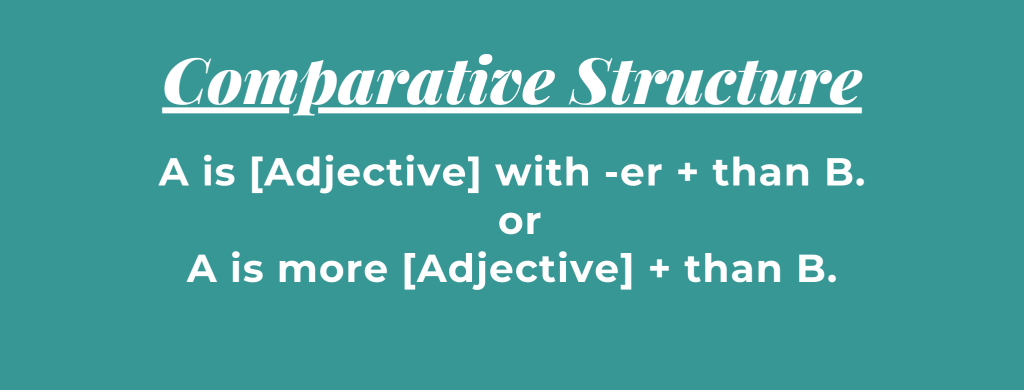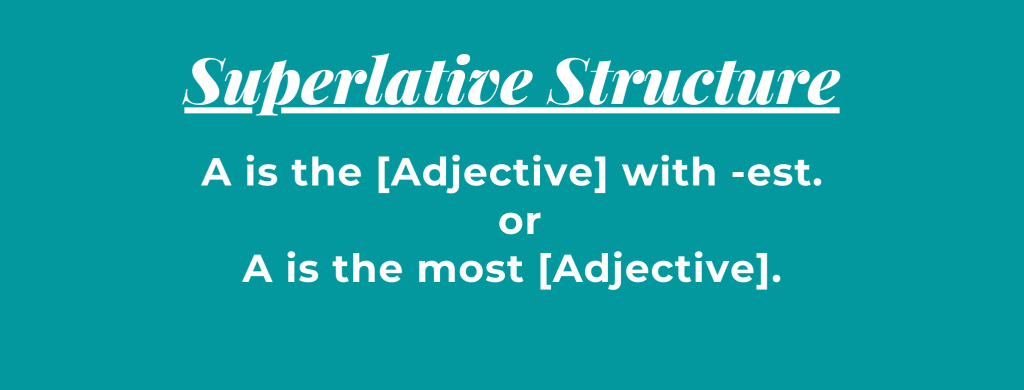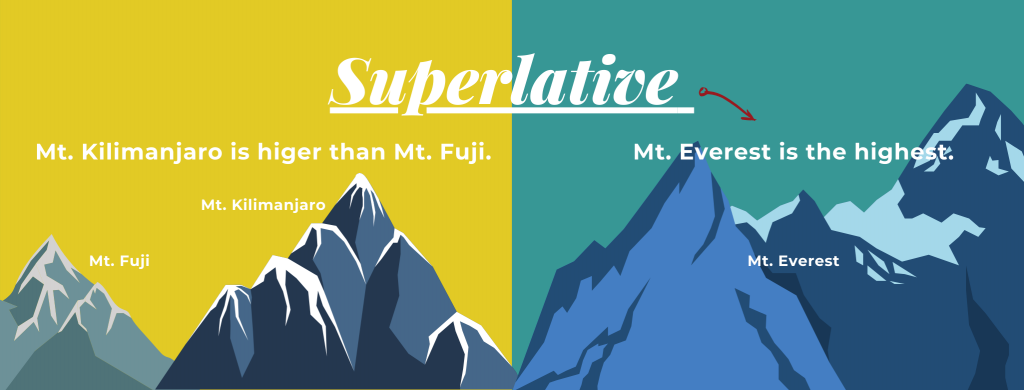หลักการเติม er: นี่คือโพสต์ที่เกี่ยวข้องกับหัวข้อนี้
หลักการใช้ที่สำคัญประการหนึ่งที่เกี่ยวเนื่องกับคำคุณศัพท์ก็คือ comparison (คอมแพริเซิ่น) หรือในภาษาไทยเรียกว่า “การเปรียบเทียบ” สามารถจำแนกได้ 2 ระดับคือ
1. Comparative adjectives
2. Superlative adjectives
Comparative adjectives (คอมแพราทิฟวฺ แอ็ดเจ็กทิฟสฺ) หมายถึง “คุณศัพท์ขั้นกว่า” แสดงความหมายว่า มากกว่า/น้อยกว่า ส่วน Superlative adjectives (ซูเพอลาทิฟวฺ แอ็ดเจ็กทิฟสฺ) หมายถึง “คุณศัพท์ขั้นสุด” แสดงความหมายมากที่สุด/น้อยที่สุด คุณศัพท์ทั้งสองแบบนี้พอจะสรุปรูปของคำได้ดังนี้
1. คุณศัพท์พยางค์เดียว (one-syllable adjectives)
เมื่อต้องการเปลี่ยนรูปของคำคุณศัพท์ประเภทนี้ให้เป็น comparative adjectives และ superlative adjectives ให้เติม -er และ -est ท้ายคำคุณศัพท์นั้นตามลำดับ เช่น
Adjectives Comparative Superlative
small smaller smallest
cheap cheaper cheapest
young younger youngest
long longer longest
big bigger biggest
high higher highest
low lower lowest
short shorter shortest
dim dimmer dimmest
glad gladder gladdest
fair fairer fairest
ตัวอย่าง
Mount Manaslu is the lowest mountain.
ภูเขามานาสลูเป็นภูเขาที่ต่ำที่สุด
Mount Kangchenjunga is higher than Mount Manaslu.
ภูเขากังเจนจังก้าสูงกว่าภูเขามานาสลู
Mount Kangchenjunga is higher than Mount Manaslu, but lower than Mount Everest.
ภูเขากังเจนจังก้าสูงกว่าภูเขามานาสลู แต่ต่ำกว่าภูเขาเอเวอเรสต์
Mount Everest is the highest mountain.
ภูเขาเอเวอเรสต์เป็นภูเขาที่สูงที่สุด
2. คุณศัพท์สองพยางค์ (two-syllable adjectives)
คำคุณศัพท์บางคำที่มีสองพยางค์ เมื่อต้องการทำให้เป็น comparative adjectives และ superlative adjectives ให้เติม -er และ -est ท้ายคำ คุณศัพท์นั้นตามลำดับ เช่น
Adjectives Comparative Superlative
quiet quieter quietest
clever cleverer cleverest
noble nobler noblest
ตัวอย่าง
This room is quieter than that one.
ห้องนี้เงียบกว่าห้องนั้น
Malee is the cleverest of all the students.
มาลีเป็นเด็กที่ฉลาดที่สุดในจำนวนเด็กนักเรียนทุกคน
คุณศัพท์สองพยางค์ที่ลงท้ายด้วย “consonant + y” (พยัญชนะ + y) ให้เปลี่ยน y เป็น i แล้วเติม -er เมื่อเป็น comparative adjectives และเติม -est เมื่อเป็น superlative adjectives เช่น
Adjectives Comparative Superlative
funny funnier funniest
easy easier easiest
jolly jollier jolliest
friendly friendlier friendliest
hungry hungrier hungriest
happy happier happiest
muddy muddier muddiest
handy handier handiest
messy messier messiest
ตัวอย่าง
Riding a bicycle is easier than driving a car.
การขี่จักรยานง่ายกว่าการขับรถยนต์
He has a happier life than she is.
เขามีชีวิตที่สุขสบายกว่าเธอ
Asian people are friendlier than Europeans.
ชาวเอเชียเป็นมิตรกว่าชาวยุโรป
คุณศัพท์สองพยางค์บางคำ เมื่อเป็น comparative adjectives และ superlative adjectives มีได้ 2 รูป กล่าวคือ เติม -er ท้ายคุณศัพท์หรือเติม more หน้าคุณศัพท์ และเติม -est ท้ายคุณศัพท์ หรือเติม most หน้าคุณศัพท์นั้นๆ ตามลำดับ เช่น
หมายเหตุ more (มากกว่า) ตรงข้ามกับ less (น้อยกว่า)
most (มากที่สุด) “ ” least (น้อยที่สุด)
Adjectives Comparative Superlative
common (ธรรมดา) commoner commonest
more common most common
cruel (โหดร้าย) crueller cruellest
more cruel most cruel
gentle (นิ่มนวล) gentler gentlest
more gentle most gentle
handsome (หล่อ) handsomer handsomest
more handsome most handsome
likely (มีแนวโน้ม) likelier likeliest
more likely most likely
mature (เป็นผู้ใหญ่) maturer maturest
more mature most mature
narrow (แคบ) narrower narrowest
more narrow most narrow
obscure (ไม่แจ่มชัด) obscurer obscurest
more obscure most obscure
pleasant (น่ารื่นรมย์) pleasanter pleasantest
more pleasant most pleasant
polite (สุภาพ) politer politest
more polite most polite
remote (ไกล) remoter remotest
more remote most remote
shallow (ตื้น) shallower shallowest
more shallow most shallow
simple (เรียบง่าย) simpler simplest
more simple most simple
stupid (โง่) stupider stupidest
more stupid most stupid
subtle (เด่นชัด) subtler subtlest
more subtle most subtle
ตัวอย่าง
Life in the country is simpler than life in the city.
ชีวิตในชนบทเรียบง่ายกว่าชีวิตในเมือง
Exposure to sunlight is one of the most common causes of cancer.
การรับแสงอาทิตย์มากเป็นสาเหตุของการเกิดมะเร็งมากที่สุดประการหนึ่ง
คุณศัพท์สองพยางค์ที่ลงท้ายด้วย -ing, -ful, -ous หรือ -ed เมื่อเป็น comparative และ superlative จะวาง more และ most ไว้หน้าคำคุณศัพท์นั้น ตามลำดับ เช่น
Adjectives Comparative Superlative
precious (มีค่าหรือราคา) more precious most precious
advanced (ก้าวหน้า) more advanced most advanced
tiring (เบื่อ, เหนื่อย) more tiring most tiring
cheerful (ร่าเริงแจ่มใส) more cheerful most cheerful
ตัวอย่าง
Technology today is more advaned than that in the past.
เทคโนโลยีปัจจุบันลํ้าหน้ากว่าเทคโนโลยีในสมัยก่อน
Teaching is less tiring than doing clerical work.
การสอนน่าเบื่อน้อยกว่าการทำงานเสมียน
3. คุณศัพท์สามพยางค์หรือมากกว่า (three-syllable adjectives or more)
คุณศัพท์ตั้งแต่สามพยางค์ขึ้นไป เมื่อเป็น comparatives และ superlatives จะวาง more และ most ไว้หน้าคุณศัพท์นั้นๆ ตามลำดับ เช่น
หมายเหตุ more (มากกว่า) ตรงข้ามกับ less (น้อยกว่า)
most (มากที่สุด) “ ” least (น้อยที่สุด)
Adjectives Comparative Superlative
stupid (โง่) more stupid most stupid
interesting (น่าสนใจ) more interesting most interesting
popular (เป็นที่นิยม) more popular most popular
important (สำศัญ) more important most important
extraordinary (แปลก) more extraordinary most extraordinary comfortable (สบาย) more comfortable most comfortable
convenient (สะดวก) more convenient most convenient
profitable (ทำกำไร) more profitable most profitable
sophisticated (ลํ้าหน้า) more sophisticated most sophisticated
ตัวอย่าง
Things are becoming more expensive these days.
สิ่งต่างๆ มีราคาแพงขึ้นทุกวันนี้
Good health is more important than money.
สุขภาพดีสำคัญกว่าเงิน
What’s the most interesting book you’ve ever read?
หนังสือเล่มใดที่น่าสนใจมากที่สุดเท่าที่คุณเคยอ่านมา
4. คุณศัพท์พิเศษ (special adjectives)
คุณศัพท์บางคำมีลักษณะพิเศษแตกต่างไปจากหลักเกณฑ์ดังกล่าวข้างต้น เมื่อทำหน้าที่ comparative adjectives และ superlative adjectives ต้องอาศัยการจำหรือใช้บ่อยๆ ได้แก่
Adjectives Comparative Superlative
good (ดี) better best
bad (แย่, เลว) worse worst
much, many (มาก) more most
little (น้อย) less least
far (ไกล) farther/further* farthest/furthest*
old (แก่,ชรา) older/elder* oldest/eldest*
หมายเหตุ คำที่ใส่เครื่องหมาย * ใช้ต่างกันดังนี้
ก. farther และ farthest นิยมใช้เมื่อกล่าวถึงระยะทาง ส่วน further และ furthest นิยมใช้วางหน้าคำนาม คือ details และ information เช่น further details แปลว่า “รายละเอียดเพิ่มเติม” อย่างไรก็ตามสามารถใช้คำทั้ง 4 กับการเปรียบเทียบระยะทางได้เช่นกัน
ข. older และ oldest ใช้แสดงการเปรียบเทียบเรื่องอายุ (age) ส่วน elder และ eldest ใช้เปรียบเทียบการเป็นพี่เป็นน้อง
ตัวอย่าง
Life in the country is worse than life in the city.
ชีวิตในชนบทแย่กว่าชีวิตในเมือง
He has a better life than she does.
เขามีชีวิตที่ดีกว่าเธอ
David is the eldest of the three boys in the family.
เดวิดเป็นพี่คนโตสุดในจำนวนพี่น้องทั้งสามคนในครอบครัว
การใช้ comparatives
1. ใช้ comparative หรือขั้นกว่า เมื่อเปรียบเทียบสิ่งหนึ่งกับอีกสิ่งหนึ่ง (แสดงว่าต้องมีสองสิ่งหรือสองบุคคลจะน้อยกว่านี้หรือเกินจากนี้ไม่ได้)ใช้โครงสร้าง
คุณศัพท์ + er / more + คุณศัพท์ … (than)
ตัวอย่าง
Martin is taller than Annie.
มาร์ตินสูงกว่าแอนนี
Annie is shorter than Martin.
แอนนี่เตี้ยกว่ามาร์ติน
Martin is taller.
(มาร์ตินสูงกว่า)
The white bag is bigger than the black bag.
กระเป๋าสีขาวใหญ่กว่ากระเป๋าสีดำ
The black bag is smaller than the white bag.
กระเป๋าสีดำเล็กกว่ากระเป๋าสีขาว
The white bag is bigger.
กระเป๋าสีขาวใหญ่กว่า
จะสังเกตเห็นว่า หลัง comparative adjectives มักจะตามด้วย than ดังนั้น taller than, bigger than, smaller than แต่บางครั้งก็มีการเอ่ยถึงสิ่งนั้นในเชิงการเปรียบเทียบกับอีกสิ่งที่ไม่ได้เอ่ยขึ้นมา แต่รู้ๆ กันอยู่แล้วว่าเป็นการเปรียบเทียบกับสิ่งนั้น ก็เพียงแต่บอกถึงสิ่งที่ “…มากกว่า” เท่านั้นก็พอ อย่างนี้ไม่ต้องมี than กล่าวโดยสรุป พอจะเขียนโครงสร้างให้จำง่ายได้ดังนี้
NOUN 1 + comparative adjective + than + NOUN 2
หรือ
NOUN 1 /NOUN 2 + comparative adjective
(หมายเหตุ เครื่องหมาย / หมายถึง “หรือ”)
ลองดูตัาอย่างเพิ่มเติม
My book is thicker than yours, (yours = your book)
หนังสือของผมหนากว่าหนังสือของคุณ
My book is thicker.
หนังสือของผมหนากว่า
Your book is thinner.
หนังสือของคุณบางกว่า
Riding a motorbike is more dangerous than driving a car.
การขับขี่รถมอเตอร์ไซค์อันตรายกว่าการขับรถยนต์
Riding a motorbike is more dangerous.
การขับขี่รถมอเตอร์ไซด์อันตรายกว่า
Driving a car is safer.
การขับรถยนต์ปลอดภัยกว่า
David’s kitchen is dirtier than mine.
ครัวของเดวิดสกปรกว่าครัวของผม
David’s kitchen is dirtier.
ครัวของเดวิดสกปรกกว่า
My kitchen is cleaner.
ครัวของผมสะอาดกว่า
หากต้องการเน้นปริมาณมากน้อยของ comparative adjectives ก็สามารถทำได้โดยวางคำหรือวลีดังต่อไปนี้ข้างหน้า comparative adjectives ได้แก่ (very) much, a lot, a little, a (little) bit, rather, หริอ far (= very much)
ตัวอย่าง
Ridding a motorbike is much more dangerous than driving a car.
การขับขี่รถมอเตอร์ไซค์อันตรายกว่าการขับรถยนต์เป็นอย่างมาก
David’s kitchen is very dirty. Mine is a little bit cleaner.
ครัวของเดวิดสกปรกมาก ครัวของผมสะอาดกว่าเล็กน้อย
อาจจะมีคำถามว่า จะวาง comparative adjectives 2 คำ ซ้อนกันโดย ไม่มีคำเชื่อมระหว่าง comparative adjectives ได้ไหม คำตอบคือ “ไม่ได้” แต่ถ้ามีคำเชื่อมระหว่าง comparative adjectives สามารถทำได้
ตัวอย่าง
X The weather is getting more colder.
/ The weather is getting colder and colder.
อากาศหนาวเย็นขึ้นๆ
X David’s kitchen is dirty, but mine is more cleaner.
/ David’s kitchen is dirty. Mine is a lot cleaner.
ครัวของเดวิดสกปรก ครัวของผมสะอาดกว่ามาก
2. ใช้ the + comparative clause, the + comparative clause เพื่อ แสดงว่าสองสิ่งนั้นผันแปรไปตามกัน ลักษณะโครงสร้างดังกล่าวนี้ เรียกว่า double comparatives เนื่องจากทั้ง 2 clauses เริ่มต้นแต่ละ clause ด้วย the + comparative adjective/adverb + ฉะนั้นจึงใช้โครงสร้าง
The + comparative clause, the + comparative clause
ตัวอย่าง
The smaller a car is, the easier it is to park.
ยิ่งรถยนต์มีขนาดเล็กลงเท่าไร ก็ยิ่งหาที่จอดได้ง่ายขึ้นเท่านั้น
The colder the weather, the higher my heating bills are.
ยิ่งอากาศหนาวเย็นลงเท่าใด ค่าใช้จ่ายด้านเครื่องทำความร้อนก็สูงขึ้นเท่านั้น
การใช้ superlatives
1. ใช้ superlative หรือขั้นสุด เมื่อมีการเปรียบเทียบสิ่งหนึ่งในจำนวนตั้งแต่สามขึ้นไป (แสดงว่า ต้องมีจำนวนตั้งแต่ 3 ถึงจะใช้ superlative ได้) โดยใช้โครงสร้าง.
the + superlative adjective/the + most/least + adjective)
ตัวอย่าง
Martin is the tallest of the three children.
มาร์ตินสูงที่สุดในจำนวนเด็กทั้งสามคน
The river Danube is the shortest.
แม่น้ำดานูบสั้นที่สุด
The river Nile is the longest.
แม่นํ้าไนล์ยาวที่สุด
John’s house is the least expensive.
บ้านของจอห์นแพงน้อยที่สุด
Bill’s house is the most expensive.
บ้านของบิลแพงที่สุด
หน้า superlative adjectives อาจจะเสริมด้วยคำหรือวลีต่อไปนี้ก็ได้ คือ easily หรือ by far ทั้งนี้เพื่อให้การเน้นย้ำมากเป็นพิเศษนั่นเอง
ตัวอย่าง
The Nile is by far the longest river in the world.
แม่น้ำไนล์นับเป็นแม่น้ำที่ยาวที่สุดในโลก
What’s easily the most interesting book you’ve ever read? หนังสือที่นับว่าน่าสนใจที่สุดที่คุณเคยอ่านมาคืออะไร
ข้อสังเกต จะเห็นได้ว่า เมื่อใช้ superlative adjectives ในประโยคจะต้องวางคำว่า the ข้างหน้าคุณศัพท์ขั้นสุดนั้นทุกครั้ง
เปรียบเทียบคาามเท่า (as + Adj + as)
นอกเหนือจากการเปรียบเทียบความต่างเป็น มากกว่า/น้อยกว่า และมากที่สุด/น้อยที่สุด ยังมีการเปรียบเทียบความเท่ากัน โดยใช้โครงสร้าง as + adjective + as และ ไม่เท่ากัน โดยใช้โครงสร้าง not as/so + adjective + as หรือ less + adjective + than ทั้งนี้ใช้ได้เฉพาะกับการเปรียบเทียบ 2 สิ่งเท่านั้น
ตัวอย่าง
Judy is as tall as Martin.
จูดี้สูงเท่ากับมาร์ติน
Somchai’s house is not as expensive as Wirat’s house.
บ้านของสมชายราคาไม่แพงเท่ากับบ้านของวิรัตน์
= Somchai’s house is less expensive than Wirat’s house.
บ้านของสมชายแพงน้อยกว่าบ้านของวิรัตน์
เปรียบเทียบความมากกว่า/น้อยกว่าของนาม (more/less/fewer + Noun + than)
นอกจากจะสามารถเปรียบเทียบระหว่างของสองสิ่งหรือบุคคลสองคนที่เกี่ยวเนื่องกับคุณสมบัติซึ่งเกี่ยวข้องโดยตรงกับ Adjectives แล้ว ยังสามารถเปรียบเทียบความมากปริมาณหรือจำนวนกว่า (more…than), น้อยปริมาณกว่า (less…than) หรือน้อยจำนวนกว่า (fewer…than) ของ Nouns ได้ด้วย โดยใช้โครงสร้าง
more + Countable/Uncountable Noun + than + Countable/ Uncountable Noun
หรีอ
fewer + Countable Noun + than + Countable Noun
หรือ
less + Uncountable Noun + than + Uncountable Noun
หมายเหตุ Countable Noun หมายถึง คำนามนับได้
Uncountable Noun หมายถึง คำนามนับไม่ได้ เครื่องหมาย/ หมายถึง “หรือ”
ตัวอย่าง
There’s more steak than chicken.
มีเนื้อสเต้กมากกว่าเนื้อไก่
There’s less chicken than steak.
มีเนื้อ ไก่น้อยกว่าเนื้อสเต้ก
There are more peaches than bananas in the bowl.
มีลูกพีชมากกว่ากล้วยในชาม
There are fewer bananas than peaches in the bowl.
มีกล้วยจำนวนน้อยกว่าลูกพีชในชาม
ดูตัวอย่างเพิ่มเติม
I eat more oranges than apples.
ผมกินส้มมากกว่าแอปเปิล
Canned food has fewer vitamins than frozen food.
อาหารกระป๋องมีวิตามินน้อยกว่าอาหารแช่แข็ง
There is less sugar than salt in this sauce.
มีนํ้าตาลน้อยกว่าเกลือในซอสชนิดนี้
ที่มา:รองศาสตราจารย์ทณุ เตียวรัตนกุล
(Visited 200,007 times, 1 visits today)
Table of Contents
[Update] Comparison of Adjectives การเปรียบเทียบคำคุณศัพท์ในภาษาอังกฤษ | หลักการเติม er – NATAVIGUIDES
Comparison of Adjectives (การเปรียบเทียบคำคุณศัพท์)
เรื่องการเปรียบเทียบคำคุณศัพท์ หรือ Comparison of Adjectives นั้นเป็นเรื่องพื้นฐานที่เข้าใจได้ไม่ยากเลยครับ ก่อนอื่นนั้นเราลองมาดูความหมายของคำว่า คำคุณศัพท์ (Adjective) กันก่อนนะครับ
คำคุณศัพท์ (Adjective) หรือตัวย่อว่า adj. ในภาษาอังกฤษนั้นคือคำที่ใช้ในการอธิบาย รูปร่าง ลักษณะนิสัย หรือคุณสมบัติต่างๆ ของคำนาม (Noun) ที่ต้องการนั่นเองครับ ตัวอย่างเช่น
tall (adj.) = สูง
a tall man = ผู้ชายตัวสูง
จากตัวอย่างนี้ tall ที่เป็น adjective ใช้ขยายคำนามคือ man เพื่อบอกรูปร่างของผู้ชายคนนี้นั่นเองครับ
ซึ่งการเปรียบเทียบคำคุณศัพท์นั้นก็คือการที่เรานำ “คำนาม 2 คำ มาเปรียบเทียบกันโดยใช้คำคุณศัพท์” ครับ จะขอยกตัวอย่างประโยคนี้นะครับ
Mike is taller than Laura.
= ไมค์ตัวสูงกว่าลอร่า
จากประโยคดังกล่าวน้องๆ จะสังเกตเห็นว่ามีการเปรียบเทียบความสูง ระหว่างคนสองคนคือไมค์และลอร่านั่นเองครับ
Comparative and Superlative (การเปรียบเทียบขั้นกว่าและขั้นสุด)
ซึ่งในภาษาอังกฤษจะมีหลักการเปรียบเทียบอยู่ 2 ข้อด้วยกันครับนั่นคือ
- Comparative (การเปรียบเทียบขั้นกว่า) และ
- Superlative (การเปรียบเทียบขั้นสุด)
เรามาเริ่มจากการเปรียบขั้นกว่าก่อนนะครับ
การเปรียบเทียบขั้นกว่านั้นจะใช้เวลาที่เราต้องการบอกว่า “A … กว่า B” อย่างประโยคที่ยกตัวอย่างไปข้างบนคือ Mike is taller than Laura ก็เป็นการเปรียบเทียบขั้นกว่าครับ ซึ่งจะมีโครงสร้างและหลักการดังนี้

หลักการเปลี่ยนรูป Adjective ใน Comparative
- หากเป็นกริยา 1-2 พยางค์ ให้เติม -er ตามด้วย than เช่น tall = taller than, deep = deeper than, high = higher than
- หากเป็นคำสั้นที่มีโครงสร้าง พยัญชนะ-สระ-พยัญชนะ ให้เพิ่มพยัญชนะท้ายเข้าไปอีกหนึ่งตัวก่อนเติม -er เช่น big = bigger
- หากเป็นคำที่ลงท้ายด้วย Y ให้เปลี่ยน Y เป็น I ก่อน จึงเติม -er เช่น pretty = prettier, heavy = heavier
- หากเป็นคำที่มี 3 พยางค์ขึ้นไป ให้ใช้โครงสร้าง more … than เช่น beautiful = more beautiful than, luxurious = more luxurious than
I am younger than your brother.
ฉันเด็กกว่าพี่ชายของคุณ
A steel is heavier than a feather.
เหล็กหนักกว่าขนนก
Monkeys are more intelligent than rabbits.
ลิงฉลาดกว่ากระต่าย
การเปรียบเทียบขั้นสุดคือการที่เราต้องการบอกว่าสิ่งนั้นคือที่สุด เช่น A หนักกว่า B แต่ C หนักที่สุด ซึ่งเราสามารถเขียนโครงสร้างได้ดังนี้ครับ

หลักการเปลี่ยนรูป Adjective ใน Superlative
- ก่อน adjective ทุกครั้งจะต้องมี the นำหน้าเสมอ
- ไม่ต้องมี than ตามหลัง adjective
- หากเป็นคำ 1-2 พยางค์ ให้เติม -est เช่น tall = the tallest , deep = the deepest, high = the highest
- หากเป็นคำสั้นที่มีโครงสร้าง พยัญชนะ-สระ-พยัญชนะ ให้เพิ่มพยัญชนะท้ายเข้าไปอีกหนึ่งตัวก่อนเติม -est เช่น big = the biggest
- หากเป็นคำที่ลงท้ายด้วย Y ให้เปลี่ยน Y เป็น I ก่อน จึงเติม -est เช่น pretty = the prettiest, heavy = the heaviest
- หากเป็นคำที่มี 3 พยางค์ขึ้นไป ให้ใช้โครงสร้าง the most … เช่น beautiful = the most beautiful than, luxurious = the most luxurious
High
Tall
Expensive
Mt. Fuji 3,776 m.
Daniel 185 cm.
Sushi 195 baht.
Mt. Everest 8,848 m.
Sara 165 cm.
Pizza 299 baht.
Mt. Kilimanjaro 5,895 m.
Emily 170 cm.
Pad Thai 60 baht.
จากตารางด้านบนเราสามารถเขียนประโยคเปรียบเทียบรูปแบบต่างๆ ได้ดังนี้ครับ
Mt. Kilimanjaro is higher than Mt. Fuji. Mt. Everest is the highest.
เทือกเขาคิรีมันจาโคสูงกว่าภูเขาไฟฟูจิ เทือกเขาเอเวอเรสต์สูงที่สุด
Emily is taller than Sara. Daniel is the tallest.
เอมิลี่สูงกว่าซาร่า ดาเนียลสูงที่สุด
Sushi is more expensive than Pad Thai. Pizza is the most expensive.
ซูชิแพงกว่าผัดไทย พิซซ่าแพงที่สุด


เป็นอย่างไรกันบ้างครับน้องๆ สำหรับเรื่อง Comparison of Adjectives ไม่ยากเลยใช่มั้ยครับ เรื่องนี้เป็นอีกเรื่องที่สำคัญมากๆ ทั้งในชีวิตประจำวันและในการสอบครับ น้องๆ อย่าลืมทบทวนบ่อยๆ ด้วยนะครับ ไว้เจอกันใหม่ในเรื่องต่อๆ ไปนะครับ
+2
suffixes การเติม -er -or -ist
นอกจากการดูบทความนี้แล้ว คุณยังสามารถดูข้อมูลที่เป็นประโยชน์อื่นๆ อีกมากมายที่เราให้ไว้ที่นี่: ดูความรู้เพิ่มเติมที่นี่

Comparisons การเติม er / est / more / most

สรุปการเปรียบเทียบขั้นเท่า ขั้นกว่า ขั้นสูงสุด
แกรมมาร์เรื่อง Comparison การเปรียบเทียบ adjective กับ adverb แบบ comparative superlative
จะใช้ as..as หรือ er / est หรือ more /most
ลองทำแบบฝึกหัดสั้นๆ ในคลิป
[ฝาก Like + Subscribe 🤍]
👇
IG : bewbamtv
FB : bewbamtv
www.bewbamtv.com
bewbamtv
บิวแบมทีวี
แจกฟรี! คู่มือเอาตัวรอดในวิชาภาษาอังกฤษ📍📍📍 FREE English Grammar Notes by BewBamTV🔖https://m.facebook.com/story.php?story_fbid=1458861710939595\u0026id=100004473400806🔖

เพลง Adjective (คำคุณศัพท์) by ครูท๊อป
วิดีโอนี้จัดทำขึ้นเพื่อการศึกษา เพื่อให้นักเรียนรู้จักคำคุณศัพท์ รู้วิธีการใช้ และรู้คำศัพท์ภาษาอังกฤษเกี่ยวกับคำคุณศัพท์

Lesson 2: Comparatives and Superlatives.
Created using PowToon Free sign up at http://www.powtoon.com/youtube/ Create animated videos and animated presentations for free. PowToon is a free tool that allows you to develop cool animated clips and animated presentations for your website, office meeting, sales pitch, nonprofit fundraiser, product launch, video resume, or anything else you could use an animated explainer video. PowToon’s animation templates help you create animated presentations and animated explainer videos from scratch. Anyone can produce awesome animations quickly with PowToon, without the cost or hassle other professional animation services require.

นอกจากการดูบทความนี้แล้ว คุณยังสามารถดูข้อมูลที่เป็นประโยชน์อื่นๆ อีกมากมายที่เราให้ไว้ที่นี่: ดูวิธีอื่นๆMAKE MONEY ONLINE
ขอบคุณมากสำหรับการดูหัวข้อโพสต์ หลักการเติม er